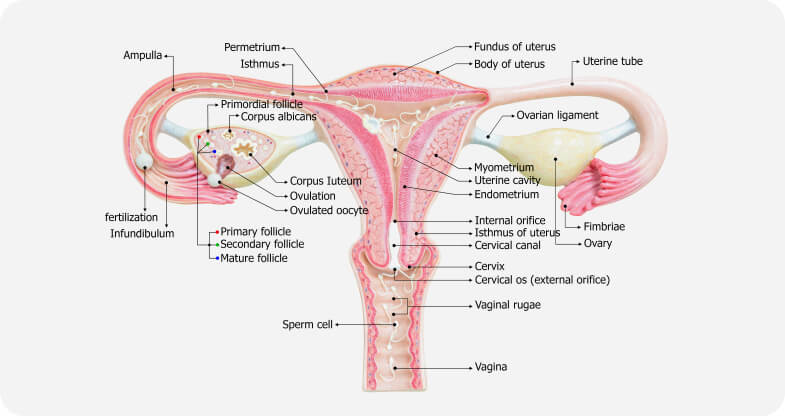Female Fertility Testing
Female fertility is simply defined as the ability to conceive a child. To truly understand female fertility and how it’s evaluated, it’s important to understand how the female reproductive system works.
Female Fertility, Explained

The female reproductive system consists of both internal and external sex organs, including the ovaries, uterus, tubes, vagina, and cervix.
The average healthy female goes through a monthly process known as ovulation, which is when a mature egg is released from one of the ovaries into the fallopian tubes. The ovaries are two oval-shaped glands that produce and store eggs. The fallopian tubes are two tubes that connect each ovary to the uterus.
In a traditional pregnancy, sperm is introduced into the female reproductive system through the male’s penis.
Beginning in the vagina, which is a flexible muscular canal that serves as the sperm’s entry point, the sperm will travel through the cervix (a narrow “gateway” opening that connects the vagina and the uterus), the uterus, and finally the fallopian tubes.
When sperm is present in the fallopian tubes at the right time, there is a window of opportunity for the sperm to fertilize the egg by penetrating through its outer shell. If successful, the fertilized egg cell will become what’s known as a zygote, which is a type of cell that’s created by two cells merging into one. This is the very beginning of embryonic development – soon the zygote will transform into a ball of rapidly dividing cells.
During this early phase, the embryo descends into the uterus, which is a hollow muscular organ that houses and gestates the fetus during pregnancy. For pregnancy to occur, the embryo must implant itself into the endometrial tissue of the uterine walls. The endometrial tissue is a special type of tissue that plays an important role in securing the embryo and supplying it with nutrients and oxygen as it develops into a fetus.
When there is no sperm present in the fallopian tubes, the unfertilized egg descends into the uterus and out of the body through the vagina. During this time, the endometrial tissue also sheds itself and exits the body along with the egg. This process is known as menstruation.

This complex system and multi-step process are governed by reproductive hormones, the most important of which are estrogen, progesterone, and, to a lesser extent, testosterone:
- Estrogen is primarily produced in the ovaries and is the main hormone involved in all aspects of ovulation, pregnancy, and fertility
- Progesterone is also primarily produced in the ovaries; its main functions are to prepare the endometrial lining for an embryo and support pregnancy
- Testosterone is produced in small quantities by the ovaries and adrenal glands; for women, it plays a supporting role the regulation of menstruation as well as libido
The average woman will first start to go through ovulation and menstruation between the ages of 11 and 14. On average, the cycle occurs once a month until menopause, which is the phase in a woman’s life when she stops ovulating. For most women, the transition into menopause generally begins somewhere between the ages of 45 and 55.
Common Female Fertility Issues
There are many factors that can impact female fertility. The female reproductive system is exceptionally complex, making it vulnerable to a wide range of systemic issues, including reproductive conditions, hormonal imbalances, and structural abnormalities. Female fertility can also be affected by age, genetics, environment, and lifestyle factors.
One of the most predominant factors to consider when it comes to female fertility is age. Unlike men, who can continue to produce sperm at older ages, women lose the ability to become naturally pregnant permanently after going through menopause.
In general, the average woman is considered to be most fertile between her late teens to late 20s. After the age of 30, her chances of conceiving naturally begin to decline, first gradually and then dramatically after the age of 35. This is because women produce a limited amount of eggs within their lifetimes. Female babies are born with approximately one to two million eggs. However, by the time they reach puberty, only about 300,000 to 400,000 eggs remain. With each ovulation cycle, 1,000 egg follicles in the ovaries will be activated, but only one egg will develop into full maturity. The egg follicles that did not produce a mature egg disintegrate and reabsorb into the body. When a woman reaches her mid to late 30s, only about 80,000 eggs remain.
Want to talk about fertility?
You’re in the right place.
How Female Infertility Is Evaluated
When evaluating female fertility, there are many diagnostic tests that may be used. These include hormone evaluations, pelvic exams, transvaginal ultrasounds, hysterosalpingograms, and diagnostic surgery.
Hormone evaluations are typically performed using blood samples, but can sometimes also require urine and/or saliva samples. Some of the most common hormone tests include:
- Follicle-stimulating hormone (FSH) testing: FSH testing plays an important role in assessing egg production and overall ovarian function
- Anti-müllerian hormone (AMH) testing: AMH testing helps to assess ovarian reserve by testing the level of AMH present in the bloodstream, which typically corresponds with the number of eggs
- Estradiol testing: Estradiol is the type of estrogen hormone that is produced by the ovaries; measuring estradiol can give insight into ovarian function
- Luteinizing hormone (LH) testing: LH is a hormone secreted by the pituitary gland in the brain; it’s the hormone responsible for triggering the release of the mature egg during ovulation






